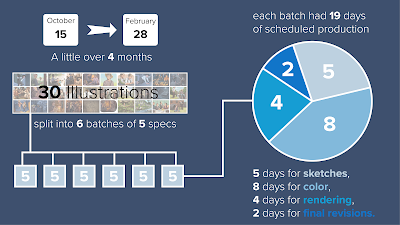Last post I talked about the help I got from my team and the trust that needed to be established with the writers and art directors. I mentioned that over the course of the next six batches, I found ways to fit my detailed, realistic style into scope, but didn't really show examples. That's because batch #2 was when I started to do a much better job of managing complex vs. simple, and implied vs. described.
Here's a perfect example of simplifying and compromise. This is an image illustrating the first time Tom and Huck meet to make a trade, Tom trading his tooth for Huck's 'first of the season' tick. He also has a dead rat. I wanted to just have Huck in the scene, considering how thin the composition was, and completely forego a background. But the authors wanted Tom in the picture, and if Tom was there, it needed a background.
In the color phase, I added Tom into the image, and the direction was two-fold: give Tom a hat, and silo the image. In other words, fade the edges of the illustration out so there were no hard corners.
I focused on Huck, especially on his hands and face, and Tom's hand. Everything else was extremely expressionistic. This helped highlight the important parts of the image and, more importantly, bought me precious time for the other four images in this batch.
That precious time was eaten up when other images went through multiple revisions.
Tom and Becky flirting was a strangely difficult piece to get right.
From sketch to color study to final revisions, it took a while to nail down everything this scene needed to show: the text on the slate, their flirting interactions, and the school house setting.
Between the time I had and the needs of the book, something had to give. I simply couldn't add a whole classroom and children at the same fidelity as Tom and Becky within the deadline. And so, again, we found a design-forward compromise.
I think it's time to talk about the compositions of my work for this project. If you know my work, you know I kind of love a dutch angle. At the very least, I like to add perspective. For most of the paintings in this project, especially early on, there were two considerations I had to keep in mind: the first was expectations of the authors, the second was, of course, timeline.
Fair or not, I came into the project with my own biases, and kept my early submissions extremely straightforward. Literally. The main characters where always center composition, horizon line was almost always in the middle of the page, and any architectural elements where always straight-on. This makes for more stagnate images, but it's also a lot faster to design and complete. I wasn't sure if the authors would be interested in more challenging designs, and it took a few batches of them seeing my work, and the consistency of my finals, for both of us to feel comfortable with more daring compositions.
There were early exceptions, however.
Even this example has the house in the background straight up and down. I was still hesitant to angle the roof too much in the foreground to enhance the perspective. Also, it's kind of amazing the conversations you get into about facial expressions. How do you show excitement but not outright happiness? Anticipation?
Anger, surprise and fear are much easier, however!
This was the first piece where I really tried to mix up the formula. How do you fit five figures into a half-page and make all of their facial expressions readable? The expressionistic background for Huck, the woodgrain silo for Tom and Becky, the flat house-front for Tom's escape, all of those little time savers were made specifically to give me space for this piece. In most batches I had one or two stand-out images that I would spend more time on to really convey the importance of the moment in the story.
Tom and Huckleberry do a lot of night time adventures and running away! I'll talk more about this one in the context of a later illustration. But in many ways I feel like this was the first draft of a later, better painting.
At this point in the schedule, I'm working on three batches at once! There was no room to breathe, especially when the deadlines would overlap one another. It's in batch #3 when we'll see that pressure start to creep up on the deadlines as I look for extra production days anywhere I can find them.































